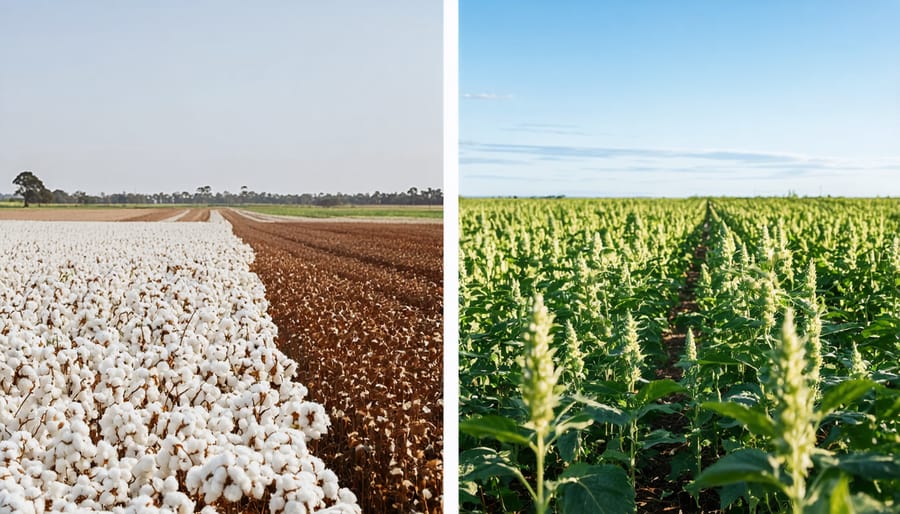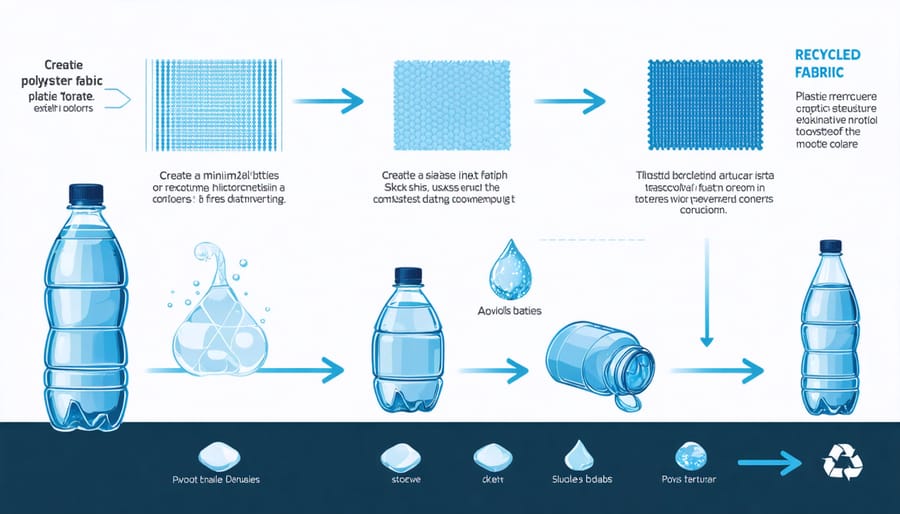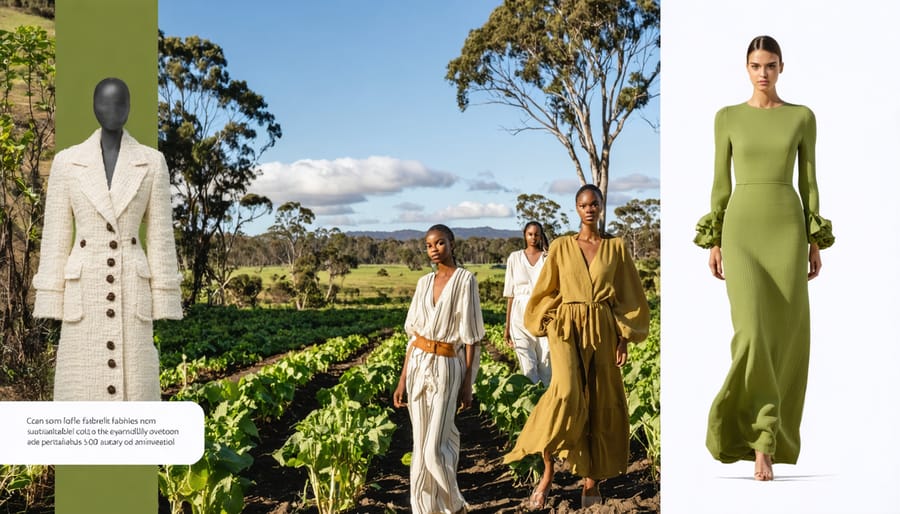The future of fashion lies in the materials we choose today. As global textile waste reaches critical levels – with over 92 million tonnes discarded annually – innovative sustainable fabrics are revolutionizing how we dress and impact our planet. From regenerative cotton grown in Australian soil to breakthrough materials crafted from agricultural waste, sustainable clothing materials aren’t just an eco-friendly choice – they’re becoming the new standard for conscious consumers and forward-thinking brands alike.
Modern sustainable textiles combine ancestral wisdom with cutting-edge technology, offering durability and style while dramatically reducing environmental impact. Hemp requires 50% less water than conventional cotton, while Australian-grown merino wool naturally biodegrades in soil within months. Innovative materials like Piñatex, created from pineapple leaf fibers, and Mycelium leather, grown from mushroom roots, demonstrate how agricultural by-products can transform into premium fashion materials.
As Australia positions itself as a leader in sustainable agriculture and innovation, our unique landscape and farming practices provide the perfect foundation for developing the next generation of eco-friendly fabrics. This shift towards sustainable materials isn’t just changing what we wear – it’s redefining the entire fashion industry’s relationship with our environment.
Natural Plant-Based Materials Leading the Way
Organic Cotton and Hemp: Australia’s Sustainable Staples
Australia’s cotton and hemp industries are leading the charge in sustainable agricultural practices, revolutionising the textile sector through innovation and environmental stewardship. Our organic cotton farmers have embraced water-efficient farming methods that use up to 90% less water than conventional cotton farming, while completely eliminating synthetic pesticides and fertilisers.
The Murray-Darling Basin, Australia’s primary cotton-growing region, has seen a remarkable transformation as farmers adopt drought-resistant varieties and precision irrigation techniques. These innovations have not only reduced water consumption but also improved soil health and biodiversity on farming properties.
Hemp cultivation is equally promising, requiring minimal water and naturally deterring pests without chemical interventions. Australian hemp farmers are producing some of the world’s finest textile-grade hemp fibre while simultaneously improving soil quality through the plant’s deep root system and natural soil-regenerating properties.
Both crops demonstrate exceptional versatility in textile production. Organic cotton provides the soft, breathable comfort Australians love, while hemp offers outstanding durability and becomes softer with each wash. The combination of these sustainable staples is creating new opportunities for local fashion brands and manufacturers committed to reducing their environmental footprint.

Bamboo and Eucalyptus-Based Fabrics
Australia’s unique climate and agricultural conditions make it perfectly suited for growing bamboo and eucalyptus, two of the most promising sustainable textile sources available today. These rapidly renewable materials are transforming the fashion industry with their minimal environmental impact and excellent comfort properties.
Bamboo fabric, derived from bamboo pulp, offers natural antibacterial properties and exceptional breathability, making it ideal for Australia’s warm climate. The plant grows incredibly fast, reaching harvest maturity in just 3-4 years, while requiring minimal water and no pesticides. Australian bamboo farms are increasingly supplying the textile industry, creating a local, sustainable supply chain.
Eucalyptus-based fabrics, particularly TENCEL™ Lyocell, represent another sustainable innovation with strong ties to Australian agriculture. These fabrics are produced from eucalyptus wood pulp using a closed-loop process that recycles 99% of the solvents used in production. The resulting material is not only biodegradable but also exceptionally soft and moisture-wicking.
Both materials demonstrate remarkable efficiency in water usage compared to cotton, with bamboo using 30% less water and eucalyptus requiring 95% less. This water efficiency is particularly crucial in Australia’s drought-prone regions. Local manufacturers are increasingly incorporating these materials into their collections, offering consumers sustainable alternatives that support both environmental conservation and regional economic development.
These renewable materials showcase how Australian natural resources can contribute to sustainable fashion while supporting local agriculture and manufacturing sectors.
Recycled and Upcycled Materials
From Plastic Bottles to Fashion
In a remarkable display of circular economy innovation, plastic bottles are finding new life in our wardrobes through an ingenious recycling process. Each year, millions of PET bottles are transformed into sustainable clothing fibres, offering a practical solution to both plastic waste and fashion’s environmental footprint.
The journey from bottle to fabric begins with collecting and sorting post-consumer PET bottles. These bottles are thoroughly cleaned, shredded into small flakes, and then melted down. The molten plastic undergoes a process called extrusion, where it’s forced through tiny holes to create fine, strong filaments. These filaments are then spun into yarn, which can be woven or knitted into fabric.
This innovative process has gained significant traction in Australia, where major retailers are increasingly incorporating recycled PET fabrics into their collections. The resulting material, often called rPET fabric, boasts impressive characteristics: it’s durable, moisture-wicking, and requires less energy to produce than virgin polyester.
The environmental benefits are substantial. Converting PET bottles into clothing helps reduce landfill waste, decreases reliance on virgin petroleum-based materials, and uses up to 50% less energy compared to conventional polyester production. On average, it takes about 10-12 plastic bottles to create one t-shirt.
Australian manufacturers are leading the charge, developing advanced recycling technologies that produce increasingly high-quality fabrics. These materials are finding their way into everything from activewear and swimsuits to corporate uniforms and outdoor gear, proving that sustainability doesn’t compromise on performance or style.
The transformation of plastic waste into fashion represents a powerful example of how innovative thinking can create practical solutions for environmental challenges.

Circular Fashion: Textile-to-Textile Recycling
In recent years, textile-to-textile recycling has emerged as a game-changing solution in sustainable fashion, perfectly complementing the zero-waste lifestyle movement. This innovative approach transforms old garments into new, high-quality fabrics, creating a circular system that significantly reduces waste and resource consumption.
Australian recycling facilities are now employing advanced mechanical and chemical processes to break down used textiles into their basic fibers. These recovered fibers are then respun into new yarns, which can be woven or knitted into fresh fabrics. The technology has evolved to maintain fiber quality through multiple recycling cycles, ensuring durability and performance in the resulting materials.
One breakthrough method involves separating blended fabrics into their constituent materials. For instance, polyester-cotton blends, previously challenging to recycle, can now be processed to recover both synthetic and natural fibers. The recovered polyester undergoes chemical recycling to create virgin-quality material, while the cotton fibers are regenerated into new cellulosic fabrics.
Local fashion brands are increasingly incorporating these recycled materials into their collections, with some achieving up to 90% recycled content in their garments. The process not only diverts textiles from landfills but also reduces water consumption and chemical use compared to virgin material production.
The future of circular fashion in Australia looks promising, with new recycling facilities being established and improved sorting technologies making the process more efficient. This transformation in textile recycling is creating opportunities for sustainable innovation while addressing the environmental impact of fashion waste.
Agricultural Waste to Wardrobe
Pineapple Leather and Fruit Fiber Fabrics
In a remarkable display of circular economy innovation, the fashion industry has embraced pineapple leather and fruit fiber fabrics as sustainable alternatives to traditional materials. Piñatex, created from pineapple leaf fibers, has emerged as a pioneering leather alternative that repurposes agricultural waste from pineapple harvests. This innovative material not only provides additional income for farming communities but also requires minimal water and zero harmful chemicals in its production.
Australian designers are increasingly incorporating these fruit-based materials into their collections, recognising their potential to reduce the fashion industry’s environmental footprint. Beyond pineapple leather, innovators are developing fabrics from orange peels, banana stems, and mango waste. These materials offer unique textures and properties while diverting tonnes of fruit industry by-products from landfill.
The durability of these materials has impressed manufacturers, with pineapple leather showing comparable strength to traditional leather in wear tests. The fabrics breathe naturally and develop a distinctive patina over time, making them particularly suitable for footwear, accessories, and upholstery.
Local fruit processors are exploring partnerships with textile manufacturers to create sustainable supply chains, turning what was once considered waste into valuable raw materials. This transformation not only supports Australia’s growing sustainable fashion sector but also creates new revenue streams for agricultural businesses while reducing their environmental impact.

Converting Sugar Cane Waste into Sustainable Textiles
In a remarkable example of circular economy innovation, Australia’s sugar cane industry is transforming its agricultural waste into sustainable textiles. The process begins with bagasse, the fibrous residue left after sugar extraction, which traditionally served merely as a bioenergy source for sugar mills. Today, this abundant byproduct is finding new life in the fashion industry.
The conversion process involves treating bagasse with eco-friendly enzymes that break down the tough fibres into a cellulose pulp. This pulp undergoes further processing to create a versatile textile material with properties similar to bamboo fabric – soft, breathable, and naturally moisture-wicking. What makes this innovation particularly exciting is that it requires no additional agricultural resources, making use of material that would otherwise be burned or discarded.
Several Australian sugar mills in Queensland have already partnered with textile manufacturers to scale up production. The resulting fabric not only provides a sustainable alternative to conventional materials but also offers additional income streams for sugar cane farmers. Early adopters in the Australian fashion industry report that garments made from bagasse-derived fabric have received enthusiastic customer response, particularly among environmentally conscious consumers.
This innovative approach to textile production demonstrates how agricultural waste can be transformed into valuable, sustainable products while supporting local industries and reducing environmental impact. As demand for sustainable fashion continues to grow, sugar cane-based textiles represent a promising solution that aligns perfectly with circular economy principles.
Making the Switch: Practical Considerations
Making the switch to sustainable clothing materials doesn’t have to be overwhelming. As part of the green revolution in Australia, more options are becoming available every day. Start by conducting a wardrobe audit to understand your current clothing composition and identify areas where sustainable alternatives can make the biggest impact.
For individuals, begin with basic items like t-shirts and undergarments made from organic cotton or bamboo fabric. These materials are readily available in Australian stores and often come with similar price points to conventional options. When shopping, look for certification labels such as GOTS (Global Organic Textile Standard) or OEKO-TEX to ensure authenticity.
Business owners can implement a gradual transition strategy by introducing sustainable materials in new product lines while phasing out less eco-friendly options. Consider starting with a capsule collection featuring recycled polyester or Tencel™ to test market response. Many Australian suppliers now offer wholesale quantities of sustainable fabrics, making the switch more economically viable than ever before.
Supply chain considerations are crucial for successful implementation. Build relationships with local suppliers who share your sustainability values and can provide consistent quality. Many Australian wool producers, for instance, are already implementing regenerative farming practices, offering excellent opportunities for partnership.
For both individuals and businesses, it’s essential to consider care instructions and longevity. Sustainable materials often require specific maintenance to maintain their quality. Invest in appropriate cleaning products and educate yourself or your customers about proper care techniques. This attention to maintenance not only extends the life of sustainable garments but also reduces their overall environmental impact.
Remember that perfection isn’t the goal – progress is. Start with small changes and gradually expand your sustainable clothing choices as you become more comfortable with new materials and sources.
The shift towards sustainable clothing materials represents a pivotal moment in fashion history, offering hope for a more environmentally conscious future. As we’ve explored, these materials not only reduce our environmental footprint but also create opportunities for innovative agricultural practices and economic growth in Australia.
The fashion industry’s embrace of sustainable materials is already showing promising results, with reduced water consumption, lower carbon emissions, and decreased reliance on harmful chemicals. Local farmers are finding new revenue streams through hemp and organic cotton cultivation, while innovative companies are developing groundbreaking solutions like seaweed-based fabrics and recycled materials.
Looking ahead, the future of sustainable clothing materials is bright. Emerging technologies in fabric development, coupled with growing consumer awareness, are driving positive change throughout the supply chain. Australian researchers and manufacturers continue to pioneer new eco-friendly materials, setting global standards for sustainability in fashion.
By choosing sustainable materials, we’re not just making a fashion statement – we’re investing in our planet’s future. These choices support local communities, preserve natural resources, and promote circular economy principles. As more brands and consumers embrace sustainable options, we’re creating a ripple effect that extends far beyond our wardrobes, fostering a more sustainable and resilient fashion industry for generations to come.
Your wardrobe choices matter. Every sustainable garment purchased helps drive this positive transformation, making you part of the solution for a greener tomorrow.

